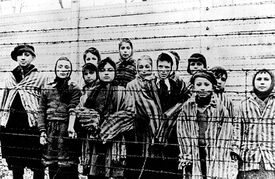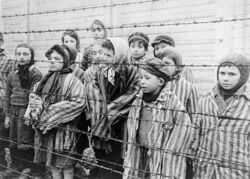Difference between revisions of "Tomy Shacham"
| Line 18: | Line 18: | ||
[[File:Auschwitz Children.jpg|250px]] | [[File:Auschwitz Children.jpg|250px]] | ||
He is present in an iconic Auschwitz picture, that depicts 13 child survivors, shortly after the liberation of the camp: | He is present in an iconic Auschwitz picture, that depicts 13 child survivors, shortly after the liberation of the camp. All of them have been identified (from left to right): | ||
*(1) [[Tomy Shacham]] / [[Tomy Schwarz]] (M / Slovakia, 1933) -- <Israel> | *(1) [[Tomy Shacham]] / [[Tomy Schwarz]] (M / Slovakia, 1933) -- <Israel> | ||
Revision as of 18:24, 2 September 2020
Tomy Shacham / Tomy Schwarz (M / Slovakia, 1933), Holocaust survivor.
- <Auschwitz> <Liberation of Auschwitz> -- <Israel>
Biography
Tomy Shacham (formerly Schwarz), was born in Nitra, Slovakia on 1 July 1933. His parents were Henrich and Alzbeta Schwarz, and he had two siblings. In 1941, the family tried to cross the border into Hungary, but were unsuccessful. In October 1944, they were taken to the Sered camp in Slovakia, and from there they were deported to Auschwitz-Birkenau on 2 November 1944. Tommy’s brother Juraj managed to escape to Hungary, but perished later on in the Budapest ghetto. The rest of the family were together in the “Family Camp” in Birkenau, but after two days, the men and the boys over age ten were separated from the women and children. At that time Tomy was eleven, but was told by his parents to say he was nine and a half. In this way, Tomy was able to spend two more days with his mother, after which she was also taken away from him, and he was left alone in the Children’s Block. On 22 January 1945, the Germans sent all the children who had survived on a march from Birkenau to an unknown destination. During the march, the Germans took flight, and the children continued alone until they arrived at Auschwitz, where they stayed until the liberation.
Tomy was liberated by the Red Army on 27 January 1945.
In March 1945, he emigrated to Eretz Israel, where he grew up to become a teacher. Today Tomy lives in Herzliyya, a father of 3 and a grandfather of 4.
Auschwitz Picture
He is present in an iconic Auschwitz picture, that depicts 13 child survivors, shortly after the liberation of the camp. All of them have been identified (from left to right):
- (1) Tomy Shacham / Tomy Schwarz (M / Slovakia, 1933) -- <Israel>
- (2) Miriam Friedman / Miriam Ziegler (F / Poland, 1933) -- <Canada>
- (3) Pessa Balter / Paula Lebovics (F / Poland, 1933)) -- <United States>
- (4) Ruth Muschkies / Ruth Webber (F / Poland, 1935)
- (5) Bracha Katz / Berta Weinhaber (F) <Israel>
- (6) Erika Dohan / Erika Winter (F / Czechia, 1931) <Israel>
- (7) Marta Wise (
- (8) Eva Slonim (
- (9) Gabor Hirsch <Switzerland>
- (10) Gabriel Neumann / Gabriel Nejman (fourth from the right) <Israel>
- (11) Shmuel Schelach / Robert Schlesinger (third from the right) <Israel>
- (12 & 13) Eva & Miriam Mozes / Eva Moses Kor & Miriam Moses Zieger (wearing knitted hats)
USF Shoah Foundation
Tomi Shaham was just 11 years old when he entered Auschwitz, but he took on the responsibility of looking after younger children in addition to helping his family and keeping himself alive for almost three months until liberation.
Tomi was born on July 1, 1933, and lived with his parents and two brothers in Nitra, Slovakia. Though his family tried to cross the border into Hungary in 1941, they were not able to escape and were sent to the Sered camp in Slovakia in October 1944. One of Tomi’s brothers escaped the camp and made it into Hungary, but Tomi later found out that he had died in the Budapest ghetto. On Nov. 3, 1944, Tomi, his remaining brother and their parents were transported to Auschwitz-Birkenau.
Because it was so late in the war, the Nazis were no longer making selections upon arrival at Auschwitz. Tomi and his family spent two days in the “family camp” section of Birkenau before the men and boys over age 10 were separated from the women and children. Tomi was 11, but his parents told him to say he was nine so he could stay with his mother and the rest of the children. After two more days, Tomi’s mother was sent away and Tomi found himself one of the oldest in the children’s block.
For the rest of his time in Birkenau, Tomi helped others. He put himself in charge of 10 children but despite his care, nine of them died of dysentery. The one boy who survived would later remember Tomi hitting him to coax him to eat so he wouldn’t die. Tomi also periodically met his father and brother through a fence. They would throw him cigarettes they got from the Red Cross so he could trade them for bread from the dysentery and typhus patients. He would then distribute it among his father and brother and the children he looked after.
As the Soviet army drew closer, the Germans at Birkenau disappeared for a week, during which time Tomi and the other children raided the storehouses for clothes and food. The rest of the adults were sent out on what would be death marches to lands that were still under German control, where Tomi’s father died, and later the children were taken on a march back to Auschwitz. But before Tomi and the others had reached Auschwitz, the Germans marching them got in a truck and drove away. The children continued on to Auschwitz anyway, and the Soviet Army liberated them on Jan. 27, 1945.
Tomi quickly befriended the Soviet soldiers and took them on a tour around Auschwitz, pointing out what each building was for. He spent so much time with them that one soldier even wanted to adopt him. After three months recuperating in Auschwitz, Tomi went to Budapest to find his uncle and learned that his mother had survived.
Tomi immigrated to Israel in March 1945, where he became a teacher – inspired, he believes, by his experiences helping the children in Auschwitz. He married and had three children and four grandchildren, and still speaks to young people about the Holocaust.

